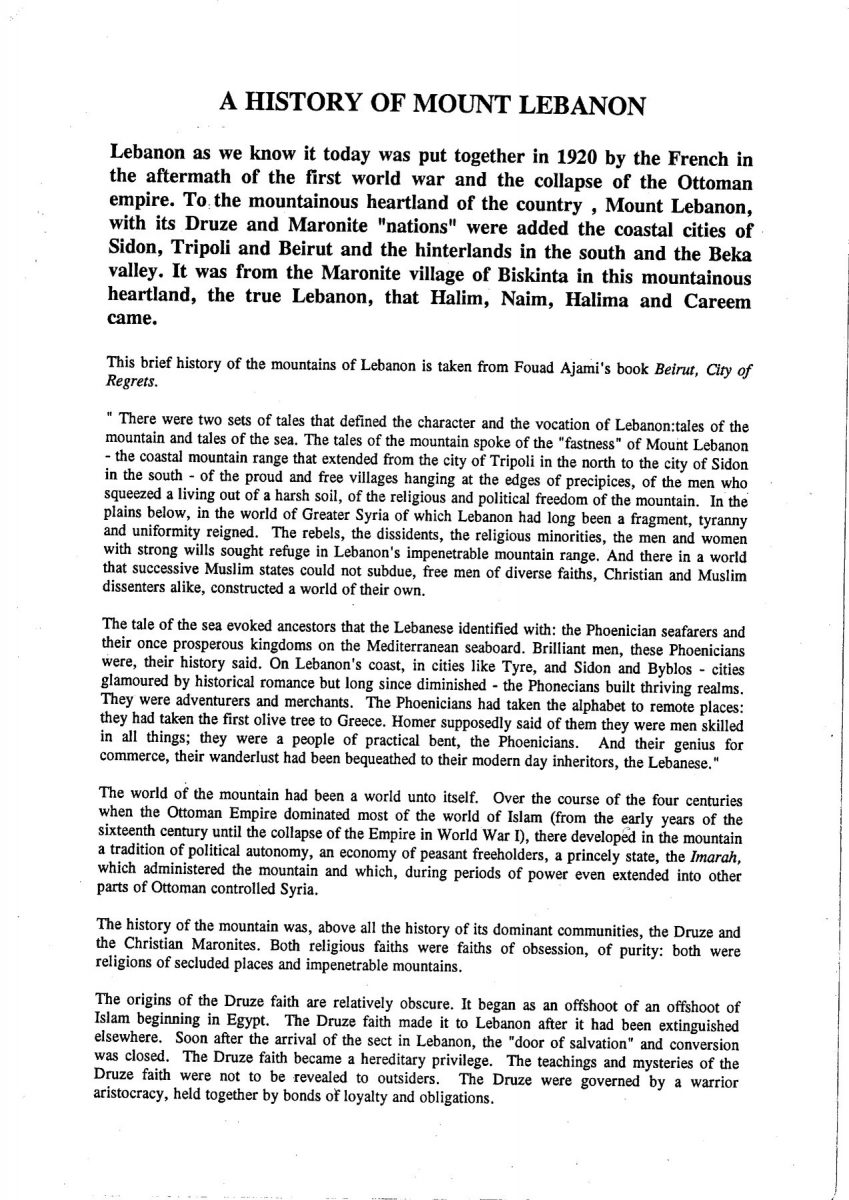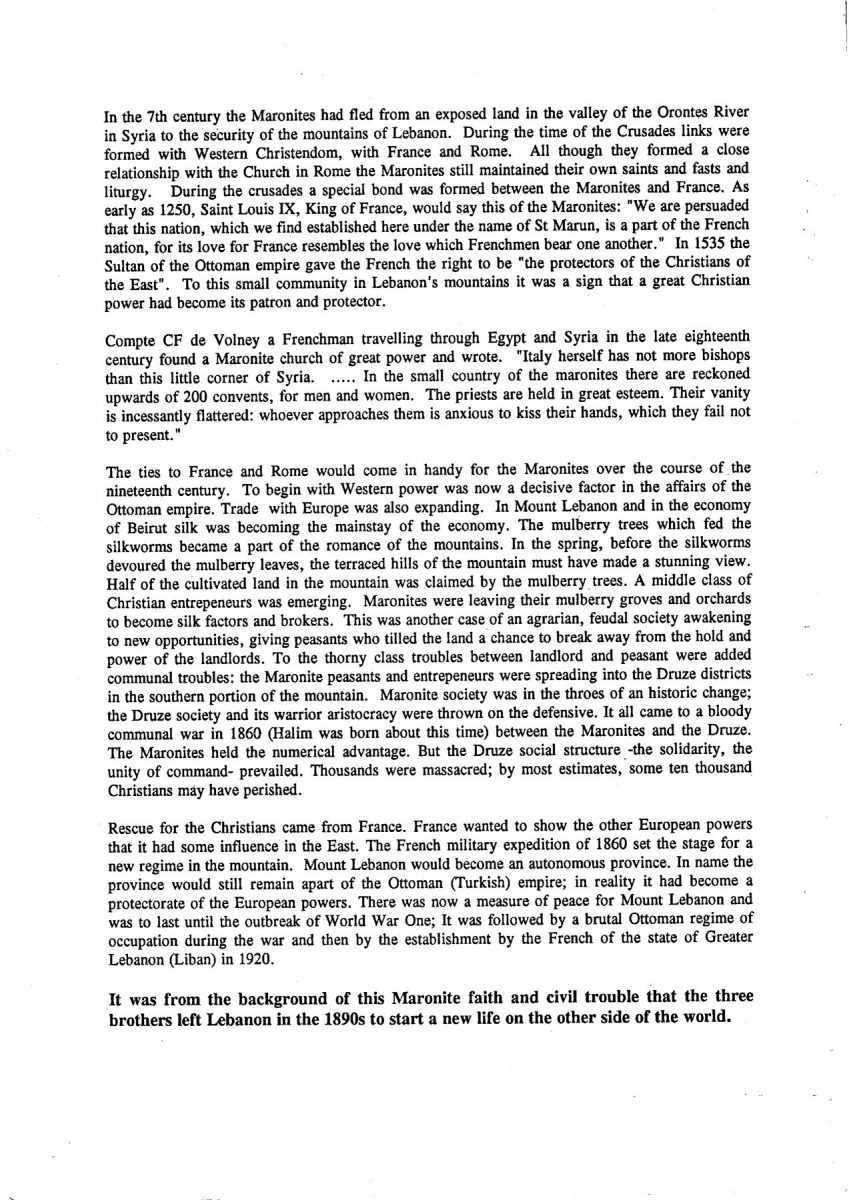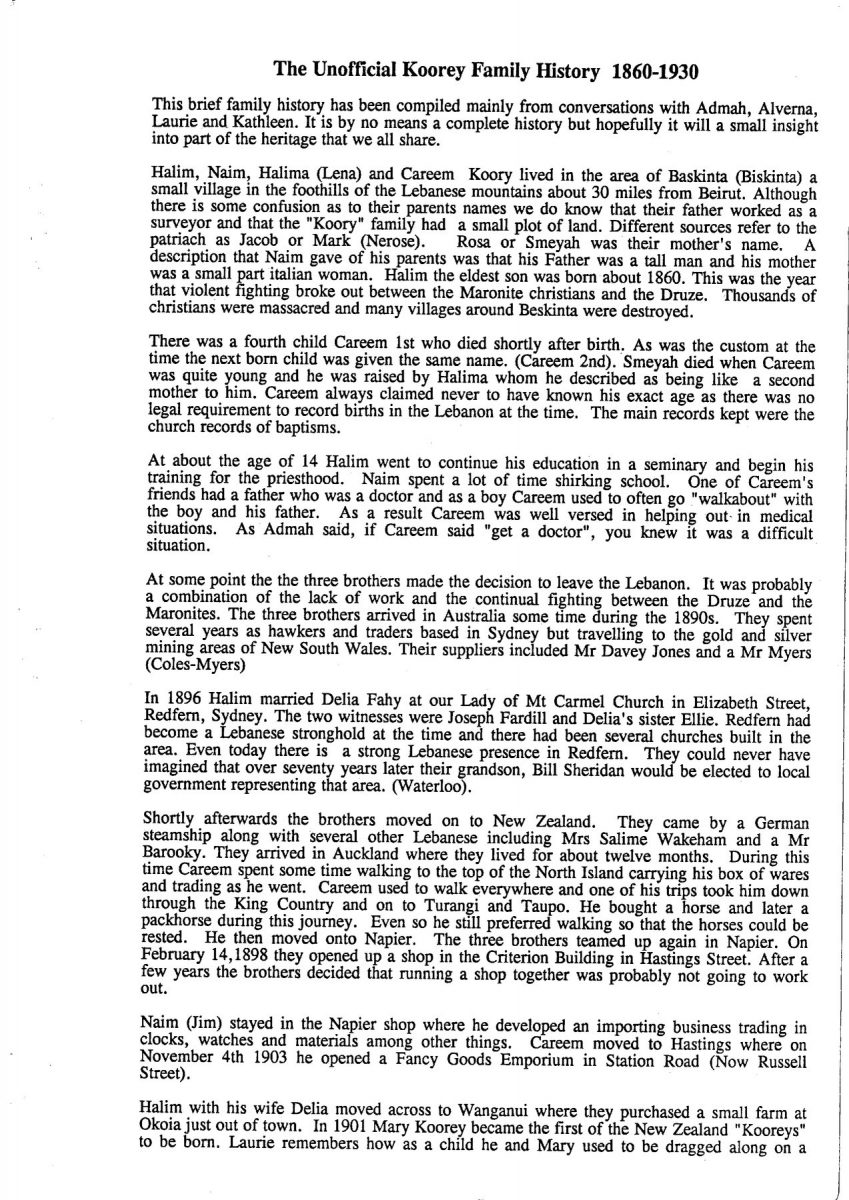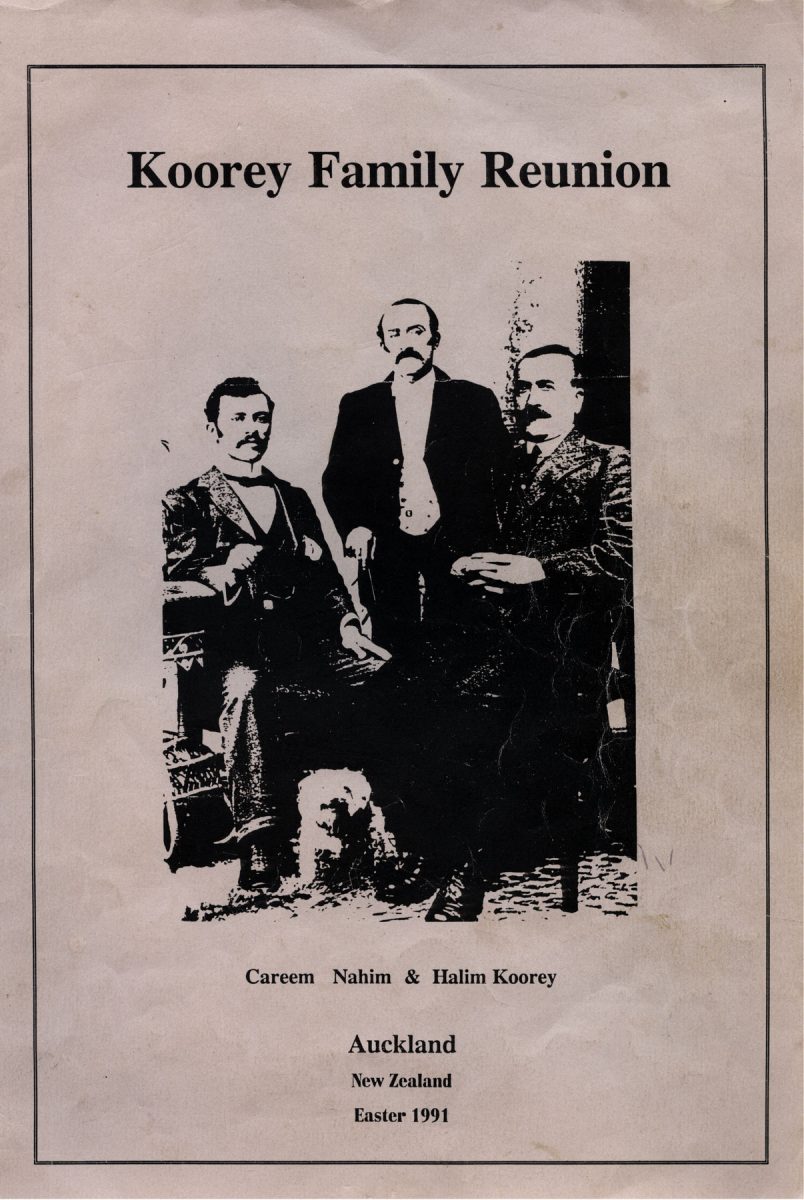- Home
- Collections
- GEOR J
- Koorey Family Reunion Booklet 1991
Koorey Family Reunion Booklet 1991
A HISTORY OF MOUNT LEBANON
Lebanon as we know it today was put together in 1920 by the French in the aftermath of the first world war and the collapse of the Ottoman empire. To the mountainous heartland of the country, Mount Lebanon, with its Druze and Maronite “nations” were added the coastal cities of Sidon, Tripoli and Beirut and the hinterlands in the south and the Beka valley. It was from the Maronite village of Biskinta in this mountainous heartland, the true Lebanon, that Halim, Naim, Halima and Careem came.
This brief history of the mountains of Lebanon is taken from Fouad Ajami’s book Beirut, City of Regrets.
” There were two sets of tales that defined the character and the vocation of Lebanon:tales of the mountain and tales of the sea. The tales of the mountain spoke of the “fastness” of Mount Lebanon – the coastal mountain range that extended from the city of Tripoli in the north to the city of Sidon in the south – of the proud and free villages hanging at the edges of precipices, of the men who squeezed a living out of a harsh soil, of the religious and political freedom of the mountain. In the plains below, in the world of Greater Syria of which Lebanon had long been a fragment, tyranny and uniformity reigned. The rebels, the dissidents, the religious minorities, the men and women with strong wills sought refuge in Lebanon’s impenetrable mountain range. And there in a world that successive Muslim states could not subdue, free men of diverse faiths, Christian and Muslim dissenters alike, constructed a world of their own.
The tale of the sea evoked ancestors that the Lebanese identified with: the Phoenician seafarers and their once prosperous kingdoms on the Mediterranean seaboard. Brilliant men, these Phoenicians were, their history said. On Lebanon’s coast, in cities like Tyre, and Sidon and Byblos – cities glamoured by historical romance but long since diminished – the Phonecians [Phoenicians] built thriving realms. They were adventurers and merchants. The Phoenicians had taken the alphabet to remote places: they had taken the first olive tree to Greece. Homer supposedly said of them they were men skilled in all things; they were a people of practical bent, the Phoenicians. And their genius for commerce, their wanderlust had been bequeathed to their modern day inheritors, the Lebanese.”
The world of the mountain had been a world unto itself. Over the course of the four centuries when the Ottoman Empire dominated most of the world of Islam (from the early years of the sixteenth century until the collapse of the Empire in World War I), there developed in the mountain a tradition of political autonomy, an economy of peasant freeholders, a princely state, the Imarah, which administered the mountain and which, during periods of power even extended into other parts of Ottoman controlled Syria.
The history of the mountain was, above all the history of its dominant communities, the Druze and the Christian Maronites. Both religious faiths were faiths of obsession, of purity: both were religions of secluded places and impenetrable mountains.
The origins of the Druze faith are relatively obscure. It began as an offshoot of an offshoot of Islam beginning in Egypt. The Druze faith made it to Lebanon after it had been extinguished elsewhere. Soon after the arrival of the sect in Lebanon, the “door of salvation” and conversion was closed. The Druze faith became a hereditary privilege. The teachings and mysteries of the Druze faith were not to be revealed to outsiders. The Druze were governed by a warrior aristocracy, held together by bonds of loyalty and obligations.

Page 2
In the 7th century the Maronites had fled from an exposed land in the valley of the Orontes River in Syria to the security of the mountains of Lebanon. During the time of the Crusades links were formed with Western Christendom, with France and Rome. All though they formed a close relationship with the Church in Rome the Maronites still maintained their own saints and fasts and liturgy. During the crusades a special bond was formed between the Maronites and France. As early as 1250, Saint Louis IX, King of France, would say this of the Maronites: “We are persuaded that this nation, which we find established here under the name of St Marun, is a part of the French nation, for its love for France resembles the love which Frenchmen bear one another.” In 1535 the Sultan of the Ottoman empire gave the French the right to be “the protectors of the Christians of the East”. To this small community in Lebanon’s mountains it was a sign that a great Christian power had become its patron and protector.
Compte CF de Volney a Frenchman travelling through Egypt and Syria in the late eighteenth century found a Maronite church of great power and wrote. “Italy herself has not more bishops than this little corner of Syria. ….. In the small country of the maronites there are reckoned upwards of 200 convents, for men and women. The priests are held in great esteem. Their vanity is incessantly flattered: whoever approaches them is anxious to kiss their hands, which they fail not to present.”
The ties to France and Rome would come in handy for the Maronites over the course of the nineteenth century. To begin with Western power was now a decisive factor in the affairs of the Ottoman empire. Trade with Europe was also expanding. In Mount Lebanon and in the economy of Beirut silk was becoming the mainstay of the economy. The mulberry trees which fed the silkworms became a part of the romance of the mountains. In the spring, before the silkworms devoured the mulberry leaves, the terraced hills of the mountain must have made a stunning view. Half of the cultivated land in the mountain was claimed by the mulberry trees. A middle class of Christian entrepeneurs was emerging. Maronites were leaving their mulberry groves and orchards to become silk factors and brokers. This was another case of an agrarian, feudal society awakening to new opportunities, giving peasants who tilled the land a chance to break away from the hold and power of the landlords. To the thorny class troubles between landlord and peasant were added communal troubles: the Maronite peasants and entrepeneurs were spreading into the Druze districts in the southern portion of the mountain. Maronite society was in the throes of an historic change; the Druze society and its warrior aristocracy were thrown on the defensive. It all came to a bloody communal war in 1860 (Halim was born about this time) between the Maronites and the Druze. The Maronites held the numerical advantage. But the Druze social structure -the solidarity, the unity of command- prevailed. Thousands were massacred; by most estimates, some ten thousand Christians may have perished.
Rescue for the Christians came from France. France wanted to show the other European powers that it had some influence in the East. The French military expedition of 1860 set the stage for a new regime in the mountain. Mount Lebanon would become an autonomous province. In name the province would still remain apart [a part] of the Ottoman (Turkish) empire; in reality it had become a protectorate of the European powers. There was now a measure of peace for Mount Lebanon and was to last until the outbreak of World War One; It was followed by a brutal Ottoman regime of occupation during the war and then by the establishment by the French of the state of Greater Lebanon (Liban) in 1920.
It was from the background of this Maronite faith and civil trouble that the three brothers left Lebanon in the 1890s to start a new life on the other side of the world.

Page 3
The Unofficial Koorey Family History 1860-1930
This brief family history has been compiled mainly from conversations with Admah, Alverna, Laurie and Kathleen. It is by no means a complete history but hopefully it will [give] a small insight into part of the heritage that we all share.
Halim, Naim, Halima (Lena) and Careem Koory lived in the area of Baskinta (Biskinta) a small village in the foothills of the Lebanese mountains about 30 miles from Beirut. Although there is some confusion as to their parents names we do know that their father worked as a surveyor and that the “Koory” family had a small plot of land. Different sources refer to the patriach as Jacob or Mark (Nerose). Rosa or Smeyah was their mother’s name. A description that Naim gave of his parents was that his Father was a tall man and his mother was a small part italian woman. Halim the eldest son was born about 1860. This was the year that violent fighting broke out between the Maronite christians and the Druze. Thousands of christians were massacred and many villages around Beskinta were destroyed.
There was a fourth child Careem 1st who died shortly after birth. As was the custom at the time the next born child was given the same name. (Careem 2nd). Smeyah died when Careem was quite young and he was raised by Halima whom he described as being like a second mother to him. Careem always claimed never to have known his exact age as there was no legal requirement to record births in the Lebanon at the time. The main records kept were the church records of baptisms.
At about the age of 14 Halim went to continue his education in a seminary and begin his training for the priesthood. Naim spent a lot of time shirking school. One of Careem’s friends had a father who was a doctor and as a boy Careem used to often go “walkabout” with the boy and his father. As a result Careem was well versed in helping out in medical situations. As Admah said, if Careem said “get a doctor”, you knew it was a difficult situation.
At some point the three brothers made the decision to leave the Lebanon. It was probably a combination of the lack of work and the continual fighting between the Druze and the Maronites. The three brothers arrived in Australia some time during the 1890s. They spent several years as hawkers and traders based in Sydney but travelling to the gold and silver mining areas of New South Wales. Their suppliers included Mr Davey Jones and a Mr Myers (Coles-Myers)
In 1896 Halim married Delia Fahy at our Lady of Mt Carmel Church in Elizabeth Street, Redfern, Sydney. The two witnesses were Joseph Fardill and Delia’s sister Ellie. Redfern had become a Lebanese stronghold at the time and there had been several churches built in the area. Even today there is a strong Lebanese presence in Redfern.
They could never have imagined that over seventy years later their grandson, Bill Sheridan would be elected to local government representing that area. (Waterloo).
Shortly afterwards the brothers moved on to New Zealand. They came by a German steamship along with several other Lebanese including Mrs Salime Wakeham and a Mr Barooky. They arrived in Auckland where they lived for about twelve months. During this time Careem spent some time walking to the top of the North Island carrying his box of wares and trading as he went. Careem used to walk everywhere and one of his trips took him down through the King Country and on to Turangi and Taupo. He bought a horse and later a packhorse during this journey. Even so he still preferred walking so that the horses could be rested. He then moved onto Napier. The three brothers teamed up again in Napier. On February 14, 1898 they opened up a shop in the Criterion Building in Hastings Street. After a few years the brothers decided that running a shop together was probably not going to work out.
Naim (Jim) stayed in the Napier shop where he developed an importing business trading in clocks, watches and materials among other things. Careem moved to Hastings where on November 4th 1903 he opened a Fancy Goods Emporium in Station Road (Now Russell Street).
Halim with his wife Delia moved across to Wanganui where they purchased a small farm at Okoia just out of town. In 1901 Mary Koorey became the first of the New Zealand “Kooreys” to be born. Laurie remembers how as a child he and Mary used to be dragged along on a

Page 4
sledge behind the old chestnut mare, Kitty. She sometimes took them to school or down to get the milk. From there the family moved to the Avenue (where Farmers now is) and lived above Halim’s drapery shop. About 1915 there was a fire in the store and the Mary organised the children’s escape by leading them out across the veranda roof and down besides Dustin’s cake shop which was next door. Kathleen was six months old at the time and had to be carried out.
At around the same time Jim’s store in Napier was also burnt out as a result of a fire which started at the back of the shop. Again the family lived on the same premises as the store and had a narrow escape from the flames. Alverna remembers being thrown out of the upstairs windows and into blankets held out by firemen waiting below. There was no insurance in those days and the fire was quite a setback for Jim. The family went across to Hastings where they stayed for a short time with Halima and David at their Restaurant.
In 1904 Careem married Lilla Bell in Auckland at St Patrick’s Cathedral. They were married by Bishop Lenihan and the witnesses were James Stewart, Lilly Bell and Rosine Hannah. Jim (Naim) was also married in 1904 in Hastings to Matilda Peterson.
Halima had remained in the Lebanon, but after her husband died she came to New Zealand and with her son David started a restaurant in Hastings. Her daughter Cecilia and son Chaker stayed behind in Beskinta. David died in the great influenza epidemic of 1918. Around 1925 Cecilia came out to New Zealand. Cecilia died in Wellington in 1973 without ever marrying. In her will she left money to Cheker’s son David who still lived in Beskinta. He moved with his family to an apartment in Beirut. That apartment was destroyed in the bombing and he left the Lebanon to live with his family in Cyprus. He has now moved back to the Lebanon.
In the early days the children from the Hawkes Bay families used to spend many of their holidays in Wanganui and vice-versa. Admah, Alverna and Mary were particularly close. Admah remembers travelling over to Wanganui at the start of each Christmas holiday in a train with the “two dozen Hastings sisters” going back to the motherhouse in Wanganui. Admah says that Wanganui was like a second home to her and her family and Halim and Delia were like another mother and Father. In those days Mary and Tony also used to spend some holidays in Hastings.
In Hastings and Napier Careem and Naim worked from their own shops. Across in Wanganui Halim had a “Van” pulled by a horse. In the early years he used to load the van, which was equipped with shelves and racks, with clothes and religious goods and go away for several days at a time trading. Halim was well known as far up as Jerusalem on the Wanganui River and out to Kaitoke. Every evening Delia used to say night prayers with the family and when Halim was away she used to get them to pray that Dad would have a good day selling. … and as Laurie said “We used to get down on our benders and do the decent thing”. Although the family later bought a Model T Ford Halim never learnt to drive. Louie and Laurie used to have great fun driving the family around.
After the store in the Avenue the family moved to Urqhart street and the store in Ridgeway street was opened. One of the more notable customers in that store was Ratana (Before he founded the movement). Laurie’s recollection is that he used to come into the shop “as drunk as a fowel. Dad would bundle him into a taxi and send him off to the pa”. Once he founded the Ratana church he became a very good customer of Halims. He would order several hundred pairs of trousers and several hundred blankets at a time. Unfortunately when Ratana died he still owed Halim £300 which the church never paid.
A lot of Halim’s trading was carried out with the Maori communities which were scattered around the Wanganui area. It has been said that Halim was more fluent in Maori than he was in English. Both Laurie and Kathleen have vivid memories of some of the Maori customers of their father. Laurie tells the story of seeing a Maori woman come into the shop and say “Koorey, you buy me a fur coat!” When Halim asked how she would pay for it she replied “Eh Koory allright, I got the cash!” Halim went to the warehouse to get a furcoat and when he came back the woman paid £100, put the coat on and went outside the shop sat down on the footpath and lit up her pipe.
Halim always had a lot of people on credit. He was often giving things away to people who couldn’t afford to purchase them. Some people even commented in a complimentary way that he was only in business to help the poor. On paydays he used to always head to the Rutland Hotel to collect his debts. Even when he retired Kathleen recalls him getting rides out to some of the remote areas to collect monies still owing.

Page 5
Because he was a deeply religious man Halim always enjoyed visiting Jerusalem on the Wanganui river with its convents and religious communities. In fact it was Halim who suggested to Careem in 1931 that he should go up the Wanganui river to Jerusalem to sell some of the religious goods that he was the agent for.
It was while Careem was away on this trip that disaster struck. ….New Zealand’s most devastating earthquake struck Hawkes Bay. Fortunately no family members were killed by the quake but Jim’s house and shop were destroyed by fire. About all that remained was a scorched iron safe where some of the precious stones that he had bought back from Australia were stored. Pat arrived from Wanganui with his mother, Delia in tow to see for themselves the damage. They were devastated by what they saw. Admah, Raphael, Mark and Marie Terese followed them back to Wanganui where they stayed with Delia and Halim until they were able to go back to Hastings.
Careem was quicker than Halim to adopt english as a language. Perhaps this stemmed from an experience that he had when they had first arrived in either Australia or New Zealand and he had to go and buy a ticket. He asked Jim to do it for him but Jim told him that the only way to learn was to go and do it himself. Careem later described to Admah how he stood at the counter and no one could understand him and no one offered to help him and he felt utterly alone and devastated. Cecilia talks of Careem always wanting to learn the “New Zealand” ways off his children. She recalls once when Halim was over and as usual they were talking in Arabic. At one point Careem stopped and said. “Oh well, I’ve lost it! Speak in English”
Halim is remembered by his grandchildren as a very gentle man who always had time for every one. As Kath said “He was a good father, He always made you eat your vegetables and things like that”. Kath also remembers that every morning he used to get up and light the kitchen fire. As he worked his way around the kitchen he was constantly mumbling in Arabic. Kath assumes that he was praying. Once the fire was lit he would walk off down to church. After mass he would head off and open up the shop. Even long after he retired he would still walk down to mass every morning. Halim had a reputation as a winemaker. He used to brew it and store it in the back shed. Kath reckons it would “cut your throat” but that didn’t stop Lou forcing the boards of the shed and making off with a few bottles every now and again.
Halim And Delia

Page 7
The Traders
The Koorey brothers were traders and their order books make interesting reading. Although both Halim and Careem were drapers they both had a sideline selling church supplies. We have included two extracts from Halim’s order book with one of the many interesting orders that he made up for the priests around the Wanganui region. There is also a record of one of the regular shipments that he sent by parcel post to his brother Jim (Naim) in Napier.
Goods from H Koorey to Rev Father McGrath May 12/5/05
7 assorted Prayer Books 1/4 each 0-9-4
4 Ditto 1/5 each 0-6-8
2 in red cases 1/9 each 0-3-6
2 ditto better ones 2/5 each 0-.4-10
2 20g ray of heaven 2/6 each 0-5-0
2 larger size Garden of soul 8/3 each 0-6-6
2 smaller size 2/5 each 0-4-10
1 20z Ray of Heavan 2/9 each 0-2-9
1 garden of Soul ~8 0-0-8
2 imitation of Christ 1/9 0-3-6
1 larger ” ” 1/2 0-1-2
3 Catechism 1½ each 0-0-4½
3 pictures dowle frames 7½ each 0-1-10½
½ doz smaller size 4/- doz 0-2-0
4 large single pictures 4½ each 0-1-4
2 yellow frames (pictures) 4 each 0-0-8
3 smaller silver frames 2 each 0-0-6
8 smaller yellow frames 2 each 0-1-4
1 doz lace pictures 4/6 doz 0-4-6
1 doz coloured 1/9 doz 0-1-9
1 doz assorted Badges .1/6 doz 0-1-6
2 doz smaller size ~6 doz 0-1-0
£3-5-9

Page 8
Brought Forward
1 doz crosses 1/9 doz 0-1-9
1 doz assorted medals ½ doz 0-1-2
1 doz white Rosary Beads 2/6 doz 0-2-6
1 doz black 3/- doz 0-3-0
1 doz larger size 4/- doz 0-4-0
1/2 doz brown ones 3/6 doz 0-1-9
3 Christ pictures with stand 4/- doz 0-1-0
3 ditto Pendants 3/3 doz 0-0-10
5 assorted holy water font 8/6 doz 0-3- 6½
2 marble crosses 8 each 0-1-4
1 ditto /10 each 0-0-10
1 good one 1/5 0-1-5
2 sacred heart pictures 1/3 ~6 0-1-9
2 oval shaped glasses 1/3 E 0-2-6
£4-13-1½
Return Goods 1-10-8
£3-3-7
Goods sold to My Brother Jim Koorey Napier oct 22 1920
2 Pears Men trousers 18/- 1-16-0
3 Men Shirts 7/6 1-2-6
3 ditto 7/- 1-1-0
6 men singlet 2/6 0-15-0
6 Men drawers? 2/6 0-15-0
6 peas Sock 20/- 0-10-0
£5-19-6
Sent by Parcel post to him
NEW ZEALAND PARCEL-POST
(COUNTERFOIL.)
(To be filled in by sender.)
Address of Parcel: Mr J. Koorey
Hastings St
Napier HB
Sender: H Koorey
Wanganui

Non-commercial use

This work is licensed under a Attribution-NonCommercial 3.0 New Zealand (CC BY-NC 3.0 NZ).
Commercial Use
Please contact us for information about using this material commercially.Can you help?
The Hawke's Bay Knowledge Bank relies on donations to make this material available. Please consider making a donation towards preserving our local history.
Visit our donations page for more information.
Description
[First 8 pages of 26 page booklet only reproduced here as later pages contain family trees and references to living people.]












Do you know something about this record?
Please note we cannot verify the accuracy of any information posted by the community.